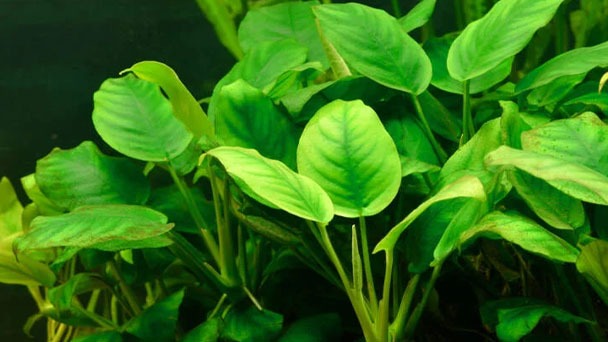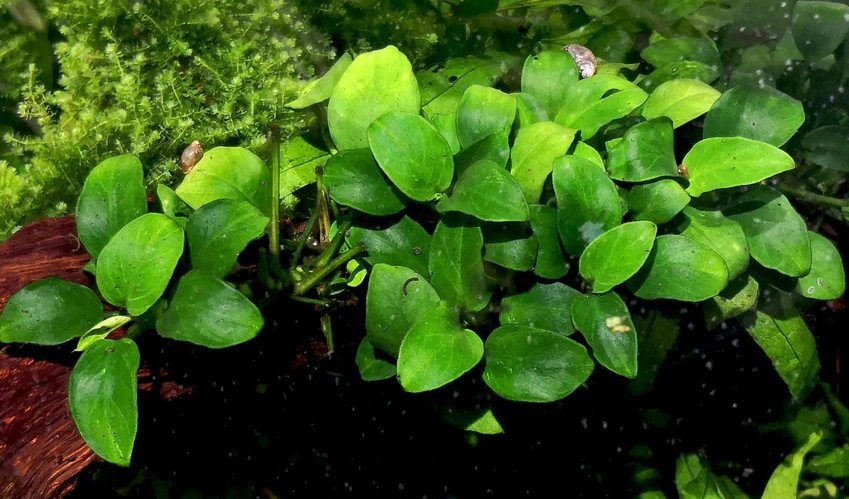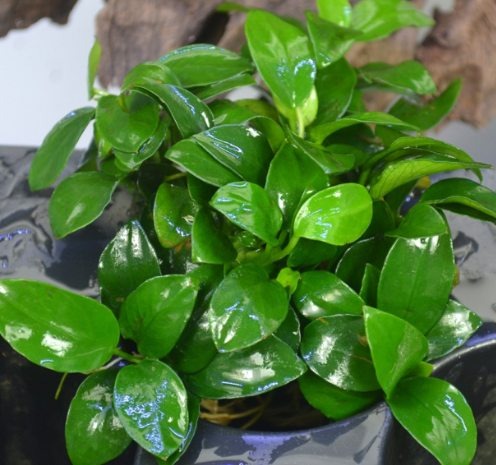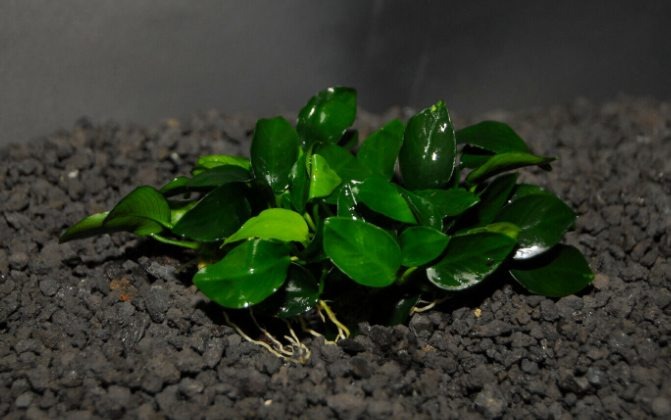Anubia Nana Care & How to Plant - 2023 Guide
Written by Ivy
Jan 03 2023

The leaves of the short plant Anubias nana are broad. It is a beautiful plant with dark green foliage that will keep the water in your tank clean and oxygenated.
Because it involves taking care of yet another item, adding plants to an aquarium can be intimidating for beginners. The good news is that this species is extremely resilient and can endure the majority of mistakes that beginners might make.
You only need to give it an occasional trim because it grows slowly. Additionally, because it is simple to grow, you can start with a small quantity and gradually spread it throughout your tank.
You will learn how to take care of Anubias nana from this article, along with ideal setups, propagation methods, and a lot more.

Anubias Nana Facts & Overview
| Category | Rating |
| Family: | Araceae |
| Care Level: | Easy |
| Growth Rate: | Slow |
| Maximum Size: | 7.5 inches |
| Minimum Tank Size: | 10 gallons |
| Water Condition: | 72-82°F, pH 6-7.5, 3-8 KH |
| Lighting: | Low-moderate |
| Propagation: | Rhizome division |
| Placement: |
Foreground to background |
Anubias nana (Anubias barteri var. nana) is a variety of the freshwater plant species Araceae family member Anubias barteri. Although these are the most typical names, it is also occasionally called dwarf Anubias.
Due to its hardiness, it can be kept under a variety of circumstances. Because it can grow either partially or fully submerged, it is well-liked for a variety of aquariums and paludariums.
It is one of the shortest plants available, making it perfect for covering the substrate and creating habitats for bottom-dwelling fish (like loaches and catfish). As a result, there is more room for free swimming higher in the water.
Their deep green leaves give the tank's bottom an attractive pop of color. Spreading this color across your tank is inexpensive and simple, and you shouldn't have any issues with propagation.
Anubias nana will also aid in regulating nitrate levels, removing pollutants, and oxygenating the water. Overall, this improves the health of the tank and lessens the amount of cleaning required.
Another plant known as Anubias nana petite (Anubias barteri var. nana petite); this is a smaller variant of the Anubias nana only reaches a height of about 5 cm.
Types of Anubias Nana
- Anubias barteri var. barteri ‘coffeefolia'
- Anubias barteri var. angustifolia
- Anubias barteri var. caladiifolia
- Anubias barteri var. glabra
Anubias Nana Size
Anubias Nana can reach heights of up to 7.5 inches (19.05 centimeters) in larger specimens. Nevertheless, the size of the plant may increase depending on the tank's conditions.
Appearance
They have a thick, dark green stem and are a very sturdy plant. Their maximum height varies depending on the tank's conditions, but it is typically around 7.5 inches.
They primarily cover the lower levels because they are so brief. Since each stem is rooted in the substrate, they rarely float to the surface. The dark green leaves branch off from the stem and have the typical teardrop shape that is found on many plants.
Despite being thin, each leaf is strengthened by its cuticle.
A creamy white flower will occasionally appear on this plant. They can flower in a paludarium setup where the plant is only partially submerged, but they can also flower when the plant is fully submerged and can thus make a great focal point plant. Once the flowers have bloomed, they can last for up to two or three months.
When several plants are kept together, you can produce a stunning color display that extends as far as you like.
The stems are anchored in place by white roots. As the plant develops, they make their way through the substrate while remaining buried after being planted.
As the roots will encircle them, you can also fasten them to rocks and bogwood if you don't want to bury them.
Anubias Nana Care
Tank Requirements
Anubias nana is a species of plant that is native to Africa. It is typically planted along river banks, either fully or partially submerged in shallow water. For photosynthesis, it has easy access to light here.
It would be simple for the roots to grow and absorb nutrients from the environment because the substrate would be soft and muddy. Warm, slightly acidic water is available. In a home aquarium, these circumstances are simple to mimic.
The water can be kept warm by using a heater. They require temperatures between 72 and 82°F, a pH between 6 and 7.5, and a KH range of 3 to 8.
Because it lets its roots expand and firmly anchor it in place, this plant thrives in fine-grained substrates.
The least likely to hurt them is sand because it is the softest material.

Light Requirements
In terms of light requirements, this plant is not very demanding.
Less than 3 watts per gallon of low lighting is what Anubias Nana prefers. They can, however, tolerate lighting that is between 3 and 5 watts per gallon.
This plant should receive 8 to 9 hours of light per day as a minimum.
A typical LED light fixture works perfectly for this plant because they don't require a lot of light. These LED lighting fixtures should have kelvin ratings of between 6500 and 7000K, which is typically best for the majority of live plant aquariums.
Because it can promote the growth of algae, moderate to high lighting should be avoided. Any amount of light exposure longer than 10 hours will also increase the likelihood of unwelcome algal growth. Because it tries to cover the entire plant, algae that grows on Anubias can be very dangerous. It is choked and unable to access nutrients as a result.
Anubias Nana can fit perfectly under the shade of other taller plants in your tank if those plants also need moderate lighting. Simply make sure they receive the necessary dim lighting since they still require some light for photosynthesis and growth.
Water Temperature
72 to 85 degrees Fahrenheit are the ideal water temperatures for Anubias Nana. To resemble their natural habitat, Anubias Nana require warm environments.
Water Flow Rate
This plant requires relatively little water to operate at its ideal flow rate. Make sure your anubias nana plant is rooted to a sturdy object, like a rock or a piece of driftwood, if your tank has strong currents.
PH Level
Between 5.5 and 7.5 is the ideal pH range for Anubias Nana's water. Instead of neutral water, it favors slightly acidic water.
Water Hardness
In tanks with water hardness levels of 2 to 6 dGH, Anubias Nana will flourish.
Heating
Heaters are necessary to maintain a suitable temperature range because the majority of anubia species prefer warmer water. Aquarists are informed if the water gets too hot thanks to thermometers.
Carbon Dioxide
Similar to substrate, CO2 setups are not required for anubias to grow. But if CO2 is available, anubias nana will grow more quickly. Pressurized and liquid versions of CO2 are both available.
Filtration
It is less directly impacted by water flow because anubias nana is at the bottom of the tank. In the event that your filter is particularly potent, keep in mind that it prefers a low to moderate current.
How to Plant Anubias Nana
There are a few things to think about when planting your Anubias nana.
Avoid planting it in shady areas. Their leaves must have access to light for photosynthesis; otherwise, they will wither away.
Make sure to give each plant room by spacing them at least two inches apart. When there are too many plants in a small area with limited resources, they will compete and some will perish as a result.
Since they would naturally grow through muddy riverbanks, roots do best in a soft substrate. Sand is a good option, but any fine-grained gravel will do.
Anubias Compatible Fish
One of the shortest plants available is Anubias nana. Aside from not directly brushing the substrate, it also has broad leaves that hang over the tank's bottom.
It is perfect for providing cover for bottom-dwellers like catfish and loaches due to these two qualities.
Few fish or other tank inhabitants cannot be housed with this plant.
But destructive fish or fish that regularly consume aquarium plants should be avoided. This is why goldfish and crayfish might not get along with this plant.
However, any tendencies to uproot plants can be easily avoided by anchoring anubias to driftwood rather than planting it in the substrate.
Therefore, there are essentially no restrictions on the kind of fish that aquarists could keep in a tank if they have chosen to display and propagate the plant in this way.
Some popular choices include:
- Kuhli, zebra, and yoyo loaches
- Corydoras and bumblebee catfish
- Dwarf and pearl gourami
- Most species of cichlids
- Mollies, barbs, danios, tetras, and guppies
Anubias nana is a plant that remains at the bottom of the tank, so not all of these fish will actually come into contact with it.
Many of these fish will still appreciate it if they swim close to bottom-dwellers, though.
As a result, the anubias nana's leaves can stay clean. These plants also thrive in the presence of algae eaters.
Planting Anubias on Driftwood
The Anubias is frequently fastened to driftwood as another common method of using this plant for aquascaping. Clear fishing line or fine cotton can be used for this task with ease. Use the cotton to gently tie the plant in place on a piece of driftwood, ornament, or other prop of your choice.
The roots don't need to be buried because they will rot if they are completely buried.
To assist in tying the roots to decorations, use cotton thread or thin fishing line. Until the roots become sturdy enough to anchor them, this will keep them safe.
You can take off the cotton ties once the plant roots have clung to the surface after a few weeks.
How to Propagate Anubias Nana
Rhizome division is the method used by this species to reproduce.
In plain English, this means that as their stems split off and fall to the substrate, they develop into their own plant.
Take cuttings from fully developed plants using sterile scissors. Put these cuttings back into the soil somewhere else; they will soon become their own plants. Their root production will begin in just a few days.
Each cutting needs at least three leaves in order for the new plant to perform photosynthesis, which is necessary for growth.
Keep your take from the original plant to a minimum because it will struggle to survive.
Although you don't need to create any special conditions in your tank for plant propagation, clean water with plenty of light, nutrients, and CO2 will help plants grow the fastest.
To achieve this, you can supplement with nutrients and CO2, but be sure to take into account how they will affect any other life in your tank.
Common Problems With Anubias Nana
Anubias Rot
Anubias rot is a possibility even if you keep them planted in the substrate. When the rhizome is totally encased in substrate, anubias rot happens. By ensuring that the rhizome is fully exposed and perched above the substrate, this can be prevented. With this plant, only the roots may be buried.
Algal Growth
This frequently occurs when Anubias Nana is housed in an aquarium with excessive lighting. To prevent this, limit daily light exposure to no more than nine or ten hours. Remove any dying or browning leaves and move the plant away from direct sunlight if you notice any algae starting to grow.
Melt
Despite being very resilient, this plant can still melt. When aquatic plants are first introduced to an aquarium, they typically go through this cycle. It is a reaction of shock to the fresh water setting. Once they become accustomed to their new surroundings, they typically adjust on their own and become healthy. If you notice no improvement, though, it may be a nutrient issue (typically involving phosphates and iron).
Overcrowding and Nutrient Competition
For removing excess nutrients from the water column, Anubias Nana is very helpful. These plants may compete with one another for nutrients in an aquarium if there are too many of them present. Because they won't get enough nutrients, this will prevent the plants from growing. In order to prevent this, it is best to only keep one specimen per 10 gallons of water.

Country of Origin
This species of anubias (Anubias barteri) is native to the shallow river banks of Africa, specifically in Cameroon and Nigeria.
It can be discovered in water that is warmer, slightly acidic, and has a light to moderate current.
They can be found in both partially submerged and fully submerged environments, as was previously mentioned.
The substrate in these locations is typically soft and muddy. Anubias nana can grow and anchor more readily as a result.
In a home aquarium, any of these conditions can be easily simulated. You won't need to fill your aquarium with mud either, as not all of these conditions are necessary.
Is Anubias Nana Suitable for Your Aquarium? (Summary)
Anubias Nana is a perfect and hardy plant that can withstand most tank conditions. The plant is additionally simple to look after. Any beginner looking to start their aquarium is advised to use this plant!
This plant can be kept in a variety of environments; most freshwater tanks are already suitable. Your Anubias nana will flourish as long as the water parameters are in the right range, there is plenty of light, and a soft substrate.
Many different fish species can be kept with this plant. Avoid species that are inclined to eat plants, though, to prevent severe harm. Problems won't be caused by the majority of other common freshwater fish.
Another benefit of this plant is that it is simple to grow more of it from cuttings, so you can start with a small amount.
Due to its hardiness, this is a well-liked choice for people of all levels of experience. You probably won't regret choosing it if you do.
FAQs
Is An Anubias Nana Good for An Aquarium?
Anubias nana is a great option for aquarium plants. It's an easy-to-grow option for aquarium enthusiasts that requires little maintenance. The plant may provide fish with a safe haven away from other fish and areas of the habitat that are well-lit. The removal of chemicals from the water that are harmful to your plants is another advantage of aquatic plants. The plant can be placed almost anywhere in the aquarium, making it a practical piece of furniture. Anubias nana naturally spreads widely, allowing you to get a lot of coverage from a single plant.
Does Anubias Nana Flower?
Fully and partially submerged conditions have been known to induce flowering in Anubias Nana.
The blooming flowers are white, cream, or light green and resemble peace lilies, a common indoor plant.
Does Anubias Nana Need Soil?
No, it is actually not advised to grow this plant in soil because the rhizome is very prone to root rot.
To completely avoid root rot, it is preferable to grow this plant on hardscape.
Why is Anubias Nana So Expensive?
For a number of reasons, this species has a reputation for being expensive.
However, the primary factor influencing this plant's price is its slow rate of growth. Because it costs farmers a lot to grow this plant, its price has increased.
Latest Updated
- Benefits of Bugleweed - 7 Science-backed Health Benefits
- Bugleweed Dangers & Side Effects - Is It Poisonous?
- How to Plant Evergreen Trees - What You Should Know
- When to Plant Evergreens - Grow Guide for Evergreen Trees
- 12 Wonderful Evergreen Shrubs for Your Garden
- 12 Popular Evergreen Plants with Pictures for Beginners
- When And How To Prune A Lilac Bush Like a Pro
- How to Grow & Care for Lilac Vine (Hardenbergia Violacea)
- Japanese Lilac Tree (Syringa Reticulata) Care & Propagation Guide
- Shumard Oak Pros and Cons - What to Know
Popular Articles
- Winter maintenance of Antirrhinum Majus
- How to Grow Terminalia Mantaly Tree
- How to Grow and Care for Crossostephium Chinense
- How to grow Antirrhinum Majus in spring
- Peristeria Elata (Dove Orchid) Profile: Info & Care Guide
- Underwatered Snake Plant (Sansevieria Trifasciata) - Signs And How To Fix
- How to Care for Brazilian Jasmine Plant (Mandevilla Sanderi)
- How to Grow & Care for Graptopetalum Purple Delight in Summer
- Rosa Chinensis (China Rose): Plant Growing & Care Tips
- How to Care for Baby Sun Rose (Aptenia Cordifolia)